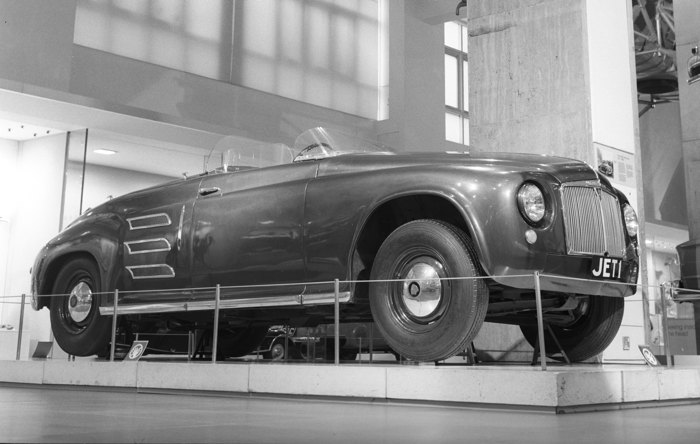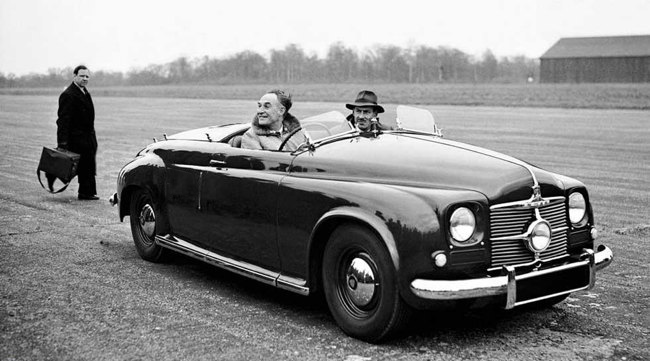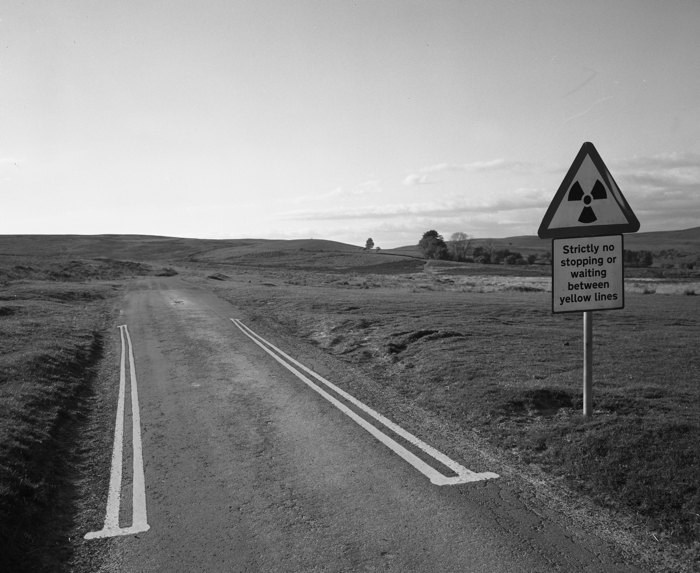 |
This week: The Experimental Nuclear Powered Rover ATOM 1 |
 The Rover Jet Turbine car as displayed today in the Science Museum London. The registration 'JET 1' can clearly be seen. The top secret nuclear powered variant was exactly the same dimensions and carried the 'ATOM 1' registration. |
| The experimental Gas Turbine-powered Rover automobile designed and tested in 1950 is well known, and that particular car is now preserved in the Science Museum London. Less well known - and even today shrouded in secrecy - was the Nuclear-Powered ATOM-1 Rover, which was tested in Wales during the Summer of 1952, something that was hailed as a huge success right up until a catastrophic failure that remains classified to this day. The late forties and early fifties were an exciting time for science and engineering. The nuclear age had just dawned and it seemed there was no application to which the new found power of the atom could not be theoretically applied. During the heady rush to build and design Nuclear Power Stations and ever more powerful weapons, a well-funded team were also instructed to experiment with smaller power units, ostensibly to give motive force to trains and buses, ships and even cars. The concept of a nuclear-powered car was vaunted as a must-have gadget for the affluent householders of the fifties, and would sell the popularity of Nuclear Power to the masses. Such a car could be hitched to your modern post-war semi-detached dwelling and used to power kitchen appliances, all the hot water, TV and heating for thirty years before refuelling at a cost 'too low to be worth raising an invoice'. Front and centre of this exciting concept was the ATOM-1 Rover advanced Nuclear Test Vehicle, a collaboration between British Nuclear Fuels and Leicester University with direct funding from the Government and the ministry of defence, who were looking into a compact nuclear power unit to be the motive force in the next generation of battle tanks. The vehicle as designed would have been capable of 150 MPH and run on .62Kg of plutonium every half century. It would sell for £780 with an option of a soft top, push-button radio and 'extra shielding' to add increased peace of mind. Unfortunately, due to a series of insurmountable obstacles, none of those targets were met, and the project was cancelled in July 1952 with little fanfare. All notes, drawings, tools, spares and a rumoured back up car 'ATOM-2' were destroyed, and those people that survived the accident in Wales were sworn to secrecy. |
 A closer shot of the air intake vents of the Turbine car. Since the ATOM car was a pressurised watercooled device, the vents on that car would have been dummies or deleted completely. |
| Needless to say, the project was not without problems, and minaturising a submarine power system to the size of a large armchair had many engineering issues, not least the abscence of a large quantity of cooling seawalter and issues over shielding, none of which were ever resolved atisfactorily. A person who claimed to have spoken to someone 'close to the project' in the sixties revealed that the power source were two pellets of Plutonium which would have been 'moved together' to initiate the nuclear reaction and generate the required heat to power a small turbine and generator set; the car itself was powered by a large electric motor that drove the front wheels. Such a setup would be unthinkable today, but in the halcyon early days of nuclear research, questionable procedures were not unusual in the quest to further knowledge. The reactor was located (it is surmised) in the back of the car as far away from the occupants as possible, and shielded first by a water jacket and then 2" thick lead shielding. The emergency scram procedure for immediate shutdown was a tank of boron slurry pumped into the fission chamber, and a fail safe spring would have moved the Plutonium pellets into lead cupolas 'to halt the reaction'. By 1952 the car was more or less functioning to within broad design parameters even though the engineers were still cautious and privately expressed doubt that a car of this complexity could be run on less than £20K a week and with a team of nine technicians. But the Government, eager to push forward into the bright sunlit uplands of the nuclear age, wanted the car to the market 'before 1955' so authorised the testing on public roads. |
 A photograph captioned 'Rover Jet Car' that experts believe is actually the ATOM car. The air intakes are absent on the rear and the registration has been blanked out. |
| A particularly empty part of Mid Wales centred around Llandrindod Wells was chosen for the testing, the routes confined to 'wide open areas'. Needless to say, the nuclear power unit was so complex that a retinue of six support vehicles and forty technicians were required to follow along behind, although 'not too close' was reputed to be the order of the day. It seems that for two weeks the testing went well, aside from heavy steering and the push buttons on the radio. Analysis of local hospital records seem to suggest that four technicians were irradiated on the 10th July 1952 or 'unspecified toxicity' as was noted on the records, with their names redacted. On July 14th 'as much lead as you can send us' was ordered from Wiggin's Specialist Metals in Hereford, a purchase that would add credibility to the suggestion that the lead shielding on ATOM-1 was inadequate. Rumours abound that the test drivers could only pilot the car for twenty minutes every three days. Otherwise, all seemed to be going well. Eyewitness accounts show a team of technicians all quite happy, the story when asked was that it was an 'advanced version' of the Jet Turbine car being evaluated. The sequence of events on the morning of the 18th July 1952 are unlikely ever fully to be known, but our source suggests that the nuclear throttle could be set in one of four positions, each corresponding to the distance between the two pellets of Plutonium. The first was 'cased' with each pellet in their lead cupola; The second was 'Low' and enough to start the reaction and to heat up the water for the turbine; the next was 'optimal' which would have been the standard setting to drive the car at a sedately 50MPH. The fourth setting was gated for safety and marked: 'Emergency overtake'. Whether the setting was accidentally tripped or deliberately in a dangerously misguided case of devil-may-care, we shall probably never know, but it is thought a failure in the throttle mechanism brought the two pellets together into critical mass, and detonated with the power of about a megaton - small by nuke standards, but enough to vaporise the car, the occupants, three of the support vehicles and blow a crater thirty feet deep on Llanbedr Hill. |
 The only evidence to suppose that a nuclear incident of Grade V seriousness ever occurred is witnessed in this one photograph. The site is on publicly accessible land at Grid Ref SO150479. |
| All that, of course, is pure supposition, but seismographs in the UK reported an earthquake in Wales, the official explanation to this day. The reaction of the government was swift; a sudden lockdown was instigated, citing an outbreak of foot and mouth disease. The area was evacuated and not reopened for six months. It is thought that the area of the accident was cleared of all topsoil which was then carted away and dumped. The lack of any articles in the press strongly suggest a 'D' notice gagging order was in force, and the incident was rapidly forgotten. The location of the accident can only be pinpointed today because of the existence of a single photograph from 1975 which clearly shows that a warning remained in place for twenty years, instructing drivers not to stop or wait at the epicentre of the blast. A visit to the site today reveals little - soil tests are inconclusive, and the sign and road markings were removed long ago, although the steel post remains. Readings with a Geiger counter displayed only a minor increase in radioactivity, and there seems to be little sign of any plant or animal mutations. Whether the Rover ATOM-1 nuclear concept car was a bold idea to make Britain lead the nuclear age, an unmitigated disaster or simply legend is unclear. But in my research for the article I met a farmer who discovered a twisted bumper a mile from the site in the winter of 1982. It was found 'clearly visible by the fact of the molten snow all around it', and when I was shown the artefact in a secret location a couple of years ago, it was still warm to the touch. Written 18th May 2020 exclusively for Jasperland. |
|
|